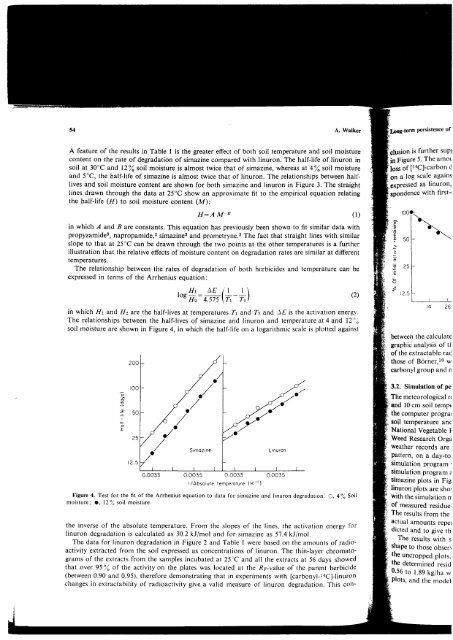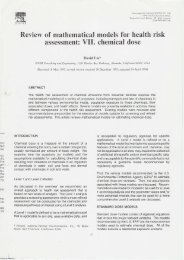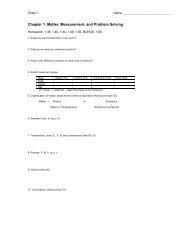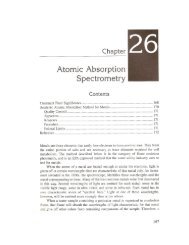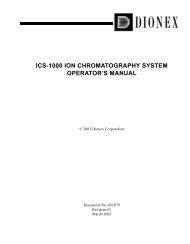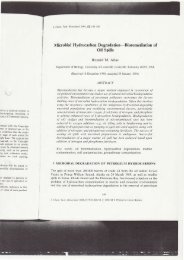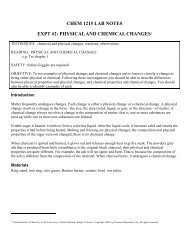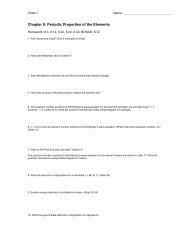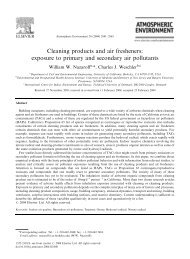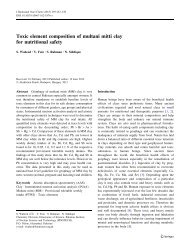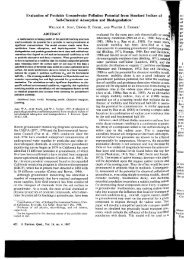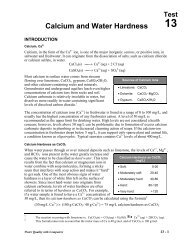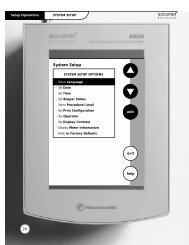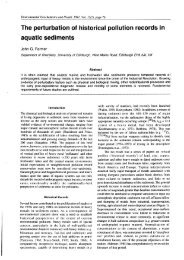Simulation of Herbicide Persistence in Soil
Simulation of Herbicide Persistence in Soil
Simulation of Herbicide Persistence in Soil
- No tags were found...
You also want an ePaper? Increase the reach of your titles
YUMPU automatically turns print PDFs into web optimized ePapers that Google loves.
A. Walker Wry-term <strong>Persistence</strong> <strong>of</strong>A feature <strong>of</strong> the results <strong>in</strong> Table I is the greater effect <strong>of</strong> both soil temperature and soil moisturecontent on the rate <strong>of</strong> degradation <strong>of</strong> simaz<strong>in</strong>e compared with l<strong>in</strong>uron. The half-life <strong>of</strong> l<strong>in</strong>uron <strong>in</strong>soil at 30"C andl2l soil moisture is almost twice that <strong>of</strong> simaz<strong>in</strong>e, whereas at4lsoil moistureand 5"C, the half-life <strong>of</strong> simaz<strong>in</strong>e is almost twice that <strong>of</strong> l<strong>in</strong>uron. The relationships between halflivesand soil moisture content are shown for both simaz<strong>in</strong>e and l<strong>in</strong>uron <strong>in</strong> Figure 3. The straightl<strong>in</strong>es drawn through the data at 25"C show an approximate fit to the empirical equation relat<strong>in</strong>gthe half-life (H) to soil moisture content (M):H:AM B (l)<strong>in</strong> which A and B are constants. This equation has previously been shown to fit similar data withpropyzamidee, napropamide,2 simaz<strong>in</strong>e3 and prometryne.3 The fact that straight l<strong>in</strong>es with similarslope to that at 25"C can be drawn through the two po<strong>in</strong>ts at the other temperatures is a furtherillustration that the relative effects <strong>of</strong> moisture content on degradation rates are similar at differenttemperatures.The relationship between the rates <strong>of</strong> degradation <strong>of</strong> both herbicides and temperature can beexpressed <strong>in</strong> terms <strong>of</strong> the Arrhenius equation:' Ht lF'l l\be'n,:#i(n-Z I tzt<strong>in</strong> which Ht and 11: are the half-lives at temperatures Ir and Tz and -lE is the activation energy.The relationships between the half-lives <strong>of</strong> simaz<strong>in</strong>e and l<strong>in</strong>uron and temperature at 4 and 12i(soil moisture are shown <strong>in</strong> Figure 4, <strong>in</strong> which the half-life on a logarithmic scale is plotted aga<strong>in</strong>st;= oro.oo35| /Absolute temperolure ( K -')Figure 4, Test for the fit <strong>of</strong> the Arrhenius equation to data for simaz<strong>in</strong>e and l<strong>in</strong>uron degradation. O,4%<strong>Soil</strong>moisture ; O, l2',r" soil moisture.the <strong>in</strong>verse <strong>of</strong> the absolute temperature. From the slopes <strong>of</strong> the l<strong>in</strong>es, the activation energy forl<strong>in</strong>uron degradation is calculated as 30.2 kJ/mol and for simaz<strong>in</strong>e as 57.4kJ/mol.The data for l<strong>in</strong>uron degradation <strong>in</strong> Figure 2 and Table I were based on the amounts <strong>of</strong> radioactivityextracted from the soil expressed as concentrations <strong>of</strong> l<strong>in</strong>uron. The th<strong>in</strong>-layer chromatograms<strong>of</strong> the extracts from the samples <strong>in</strong>cubated at 25"C and all the extracts at 56 days showedthat over 957" <strong>of</strong> the activity on the plates was located at the Rr,-value <strong>of</strong> the parent herbicide(between 0.90 and 0.95), therefore demonstrat<strong>in</strong>g that <strong>in</strong> experiments with [carbonyl-1aC]-l<strong>in</strong>uronchanges <strong>in</strong> extractability <strong>of</strong> radioactivity give a valid measure <strong>of</strong> l<strong>in</strong>uron degradation. This con-clusion is further suPl<strong>in</strong> Figure 5. The amotloss <strong>of</strong> [raC]-carbon don a log scale aga<strong>in</strong>sexpressed as l<strong>in</strong>uron,spondence with first-'srooQa\t z,)between the calculategraphic analysis <strong>of</strong> tt<strong>of</strong> the extractable raCthose <strong>of</strong> Bcirner,lo wcarbonyl group and n3.2. <strong>Simulation</strong> <strong>of</strong> peThe meteorological rrand l0 cm soil temp(the computer prograrsoil temperature ancNational Vegetable IWeed Research Orgaweather records arepattern, on a day-tosimulation program'simulation program €simaz<strong>in</strong>e plots <strong>in</strong> Figl<strong>in</strong>uron plots are sho,with the simulation n<strong>of</strong> measured residueThe results from theactual amounts repeidicted and to give thThe results with sshape to those obserrthe uncropped plots,the determ<strong>in</strong>ed resid0.56 to l.g9 kg/ha wPlots, and the model


